- Home
- Timothy Egan
Short Nights of the Shadow Catcher Page 2
Short Nights of the Shadow Catcher Read online
Page 2
Education, sporadic at best, was in a one-room schoolhouse. The sickly father, when he felt up to it, hit the road spreading Bible verses. The preacher took his boy along on many of his ministry forays. They went by canoe, just as the Indians had done, plying the waterways of still wild Minnesota. Ed learned to make a fire and cook a meal out of whatever fish or salamander he could find or warm-blooded critter he could shoot. The gothic Christianity of the United Brethren Church was not for him; it was so joyless, so life-smothering with its rules and prohibitions. But the outdoors, the open country—there was a church Ed Curtis could feel at home in. His formal schooling ended in sixth grade. About the same time, at the age of twelve, he discovered his father’s Civil War lens. Following instructions in Wilson’s Photographics, he built a camera consisting of two boxes, one inside the other. It was a primitive device, but transformative and thrilling, for it could capture life in the marshes of Minnesota and in the faces of family and friends. It made young Curtis feel like something other than a mule.
When his oldest brother, Raphael, left the house, Curtis had to put the camera aside. The preacher grew more sickly and useless. The fatal taint of the war had never left him. At fourteen, Ed Curtis inherited a heavy burden: he would have to support the whole family, including both parents. He got a job working for the railroad, rising to become a supervisor. Because of his height, he looked much older than his actual age. He killed muskrat and turtle still, brought more fish to the family table, tilled a large garden, used his earnings for cloth and sugar and tobacco. The winter of 1886–87 nearly finished off the Curtis family. The preacher was bedridden during the cold months, wailing and complaining. In the spring, the fledgling crops of the new season died in a seizure of frost. The money from the rail job dried up after one of the periodic panics that shut down the unregulated American economy. Broke, facing real hunger and no future, the Curtis family was left with no option but to look west.
In the fall of 1887, Ed Curtis and his father arrived in the Puget Sound area, which was opening up to land opportunists after treaties had removed most of the Indian, and all of the British, claims to the region. Danes, Swedes and other Nordics were flooding into Washington Territory, marveling at how the fjords and forests reminded them of northern Europe. Irish and Germans came because of good word of mouth from family members. But mostly, the fresh-starters were other midwesterners, leaving the flatlands after the economic busts of the 1880s for another chance at a tabula rasa. Here was Eden in the mist. “Bays within bays, inlets on inlets, seas linking seas—over 12,000 square miles of surface, the waters come and go, rise and fall, past a splendid succession of islands, promontories, walls of forest and towering mountains,” a reporter for the Atlantic Monthly wrote, describing perhaps the most primeval patch of temperate zone then under the American flag. “The old Indian names which still haunt the shores heighten the illusion. The wilderness is dominant still.”
That first winter for the Curtis homesteaders was wet but mild—the lows seldom falling below freezing, snowfall a rarity even though the region is farther north in latitude than Maine. The Curtis men claimed a piece of land across the water from Seattle, near a town called Sydney. Their acreage was crowded with evergreens, alders and maples, and sloped down to the sound. In the clearing, Ed Curtis could look out at tall ships on the way to Seattle, Tacoma and Port Townsend, and could see what would become a magnificent obsession—the 14,411-foot cone of Mount Rainier. From sea level to the glacial top, Rainier was the highest freestanding mountain in the United States. Everywhere Curtis turned, he took in a view dramatically unlike the Midwest. On one side were the Olympics, which held their snow until midsummer, and on the other side were the Cascades, the spine that ran down the entire midsection of the territory, dividing it between a wet half and a dry. Water was the dominant element and master architect. The green was all-encompassing.
Edward cut down spruce trees—light, straight, easily split softwood—on the family claim and built a cabin with the timber. The centerpiece was a stone fireplace, which heated the home fine. Fruit trees were planted. A big garden was established. The rest of the family—a teenage girl Eva, the youngest boy Asahel and the preacher’s wife Ellen—bundled up their belongings in the spring of 1888 and took the train out west to join the men. But just as the light of May was bringing the land to life, the old man took a turn for the worse. He had pneumonia when his family arrived, with no appetite and no energy. The Reverend Johnson Curtis died three days after the reunion.
At age twenty, Ed Curtis took up where he had left off before the move, trying to support the clan. He fished. The salmon were huge—big Chinooks weighed thirty pounds or more—and millions of them flooded the waterways that emptied into Puget Sound; all a man had to do was be minimally alert and modestly competent with net or pole. He fixed things for hire, helping widows and disabled men with bent axles and faulty stoves and broken plows. He picked berries. The orange ones, salmonberries, were the most exotic; the purple ones, huckleberries, the tastiest, though he had to hike into the foothills to get at them. He plucked oysters from the mud, dug clams, chipped mussels from half-submerged logs. He cut wood, splitting firs and spruce for house-framing purposes, and alder and maple for stove fuel. He aspired to fulfill his father’s dream to open a brickyard. In a formal photograph taken not long after Reverend Curtis died, Edward is the image of earnest ambition: clean-shaven, strong-jawed, a white tie against a white shirt, looking resolute. But then his life came to a halt after he took a terrible fall from a log, mangling his spine. At twenty-two he could barely walk, let alone lift a beam or heft a bundle of bricks. Just like his father, Curtis was confined to bed for almost a year, “limp, thin and bleached,” a neighbor boy recalled.
It was awful not being able to get around, watching his mother put together a meal of boiled potatoes and bacon grease. Out the window, though, was a world that gave flight to his spirit. He became a close observer: how the color of the land would change subtly in shifting light, the moments in midmorning when the fog lifted, or breaks in the afternoon between rain showers, when he could see the spectrum of the rainbow in a single drop held by a rhododendron leaf.
A sixteen-year-old girl, Clara Phillips, started visiting the bedridden man in the homestead cabin. She had a mane of thick dark hair, worn well past her shoulders, and exhibited a feisty independence. Clara’s family had moved around: from Canada to rural Pennsylvania, where she was born, and then to Puget Sound. The Phillips girls, Clara and her sister Nellie, were different from the other homesteader children; they used fancy words from books and were curious about things beyond the little community that would become Port Orchard. When she met Curtis, Clara had not yet finished with her schooling, and she fascinated him with all the things she knew that he did not. When Curtis talked of what he wanted to do when he regained his mobility, she alone seemed to believe him. There would be no more berry-picking or clam-digging, no more wood-cutting or fence-fixing, no more brickyard. He would no longer put his back into his living.
Clara visited one day and found Edward sitting up, enraptured by a contraption on the kitchen table: a 14-by-17-inch view camera, capable of holding a slice of life on a large-format glass-plate negative with such clarity it made people gasp. The camera was not cheap, the price much derided by Edward’s mother. He had bought it from a traveler looking to raise a stake on the way to goldfields. Ellen Curtis thought it was a waste: what was he going to do with that costly and fragile thing? Even Wilson’s Photographics, which Curtis had used to help build the camera back in Minnesota, had warned that photography was “a circus kind of business, and unfit for a gentleman to engage in.”
The healing invalid’s plan was bold: he would borrow $150 against the property and use the cash for a move to Seattle. He had heard about a picture studio in town, and it needed a new partner. The big, bustling place across the water was a short boat ride from home, but a world away from the sodden ground of the homestead. “They call it the Quee
n City and talk about its great future although it wasn’t very long ago there were Indian attacks on the town,” the preacher Johnson Curtis had written his family after he and his son put their first stakes in the ground. “It’s over 10,000 people and there’s a university in the middle of town and hills all around it. Edward says they have telephones, 120 of them!” With the 14-by-17 view camera, Curtis vowed to leave the subsistence life forever.
Newly mobile in 1891, Curtis went off to Seattle to make a go of it. What he knew about studio photography was laughable. And who would support the family? But in a new town, in a new land, he could fail almost without consequence. What he brought to the city, his sister Eva recalled, was unbridled curiosity—“always nosing into something interesting.” In Seattle the $150 stake was enough to buy Edward a name on a storefront, “Rothi and Curtis, Photographers,” and an apprenticeship to a dominating partner. Clara joined Curtis in the city, scandalizing her family. She lived in a boarding house—the same one as Curtis. Her mind was set, as was his. They married in 1892. She was eighteen, he was twenty-four.
Success came quickly. Curtis left Rothi and joined Thomas Guptill in a much bigger enterprise, a studio on Second Avenue with photoengraving facilities. The Curtis couple lived above the shop until a baby, Harold, born in 1893, prompted a move up the hill. By 1895, just four years after his prolonged convalescence, Curtis was a Seattle celebrity, his name known around the Pacific Northwest. He had money to stuff the house on Eighth Avenue with fine furniture. More importantly, it was big enough to bring the rest of the family over. His mother, his sister Eva, his brother Asahel, Clara’s sister Nellie and two of her relatives—they all moved in.
Curtis himself was seldom home. He not only mastered the artistry of working with a box to capture light and shadow and the way a personality could change with a gaze one way or a tilt of the head the other, but was equally skilled at technical details. “Finest photographic work in the city” was the claim of the studio in the Seattle directory of 1895. The next year, a Seattle paper backed that boast, predicting that “in a very few years these young men will have the largest engraving plant west of Chicago.” Curtis grew the beard that became his trademark, wore stylish clothes, learned fast how to charm the leading citizens of the city. Photoengraving was laborious; each picture was finished by hand, with a honeyed sepia tone. More than a decade earlier, George Eastman, of Rochester, New York, had developed a much easier way to process a photograph: dry gel on paper, replacing heavy plates wiped with chemicals. “You press the button, we do the rest” was the marketing slogan, put to use when the Kodak Brownie was sold starting in 1901. But Curtis wanted nothing of the shortcuts. He preferred the quality and detailing he could get with glass-plate negatives, no matter how heavy, dangerous and expensive. There was more than enough work at the studio that Curtis could hire his brother Asahel, six years younger, as an apprentice in 1895.
That Edward Curtis, at the age of twenty-seven, had made the journey from ragged forager with a dented spine to the talk of a robust town full of similar self-confident swells of the Gay Nineties would be enough for some men. But Curtis was hungry for the bigger dare. The house, the business, the family, the gadgets, the praise from the press and the nods of approval from moneyed gentlemen—it was a start. Curtis also did those nudes: bohemian, exotic women showing their nipples just above the lace, angelic faces looking bored in a gilded parlor. Curtis had left the grim-faced Christian sensibility of his father behind, like so many in the West.
His adopted city spread north, south and east, limited only by the inky depths of Puget Sound to the west. The 10,000 people Reverend Curtis had spoken of had become, in barely a decade’s time, a city of nearly 100,000, and that amount would double, and then some, in the next ten years. The climate was said to be “salubrious,” a wonderful euphemism for a place that got thirty-six inches of rain a year, most of it falling between November and March. The new inhabitants, having pushed away the Indians for a pittance, and with only a few minor skirmishes, could not believe their good fortune. Here were seven hills, the highest rising to just over five hundred feet, with the cornucopia of Puget Sound lapping at one shore and the long, clear magnificence of Lake Washington on the other, a mountain lake at sea level. You could see ten feet down in the fresh, clear waters, all that glacial-rock-filtered runoff clean enough to drink.
Between the two big bodies of water were other lakes, streams and waterfalls, even a clearing of level ground where the tribes used to gather to give away things and eat until they fell over, stuffed and happy. A garden setting it was, just as the British explorer had said, requiring virtually nothing from man to improve on it. Near Pioneer Square was a low-lying island where the natives from the reservation used to park their dugout canoes, there to sell shellfish to the three-masted schooners anchored nearby; the island lost its natural moat when it was filled with debris. Cable cars moved smartly up and down First Avenue, and buildings with Romanesque and Palladian features sprouted overnight, rivaling in height the five-century-old trees that had been in their paths.
Curtis himself was put to work on behalf of the city’s hagiography. He shot dreamy landscapes at the edge of the city, which filled a full page of a respected Seattle broadsheet, hailing “A New Garden of Eden.” A story in that annual progress edition told of a visiting Oxford don who asked about Seattle’s history. He was taken to see one of the pioneers who had been around when the city was started.
“Started!” the visitor said. “Do you realize how peculiar it is to an Englishman to hear of men who were present when a city was started?” Life in the new Northwest, the story concluded, was “wholly beyond the comprehension of the Europeans.”
There remained in the tree-shaven, steam-shoveled, hydraulic-sluiced urban makeover the stubborn figure of Chief Seattle’s last surviving child. Curtis approached Angeline now with a proposition. He tried a simple negotiation, laying out his idea. Angeline backed away, her hands deep in the pockets where she kept her rocks. Curtis used Chinook jargon, a few hundred words that had been a primitive trading language dating to the Hudson’s Bay Company days. Angeline shook her head.
“Nika halo cumtuv.”
Curtis opened his leather case and displayed a few portraits—beautiful, full-faced, radiant subjects. And such detail, like real life. He gestured to her and then to the pictures.
“Nika halo cumtuv.”
At last he reached into his pocket and produced some coins. More hand gestures followed. A simple exchange did the trick: money for picture. Up the hill they walked, Angeline pausing to rest every few steps, to the studio at 614 Second Avenue. Inside, it took some time for Curtis to persuade Angeline to get comfortable. Plenty of people had taken her picture before. It was usually quick, followed by a growl from the native woman. Curtis had her sit and look around the room, daydream if she liked, gave her some tobacco for her pipe, maybe one of his cigarettes. Of course! After some time she loosened the bandanna and the scarf.
“No, no! Just as you are.”
And the cane: he wanted the Indian’s stick of worn hardwood to be in the portrait too. It was as much a part of Angeline as the faded calico skirts. She did not smile, not even an attempt, and he did not want her to smile. He was looking for the lethal glare she saved for the boys who threw rocks at her. He hoped to convey a face that had seen worlds change, forests leveled, tidelands filled, people crushed. As a girl, she never dug a clam or washed a bit of clothing. Her father had slaves from other tribes do the menial work. Her current status, the scrubwoman in the shack, was anything but quaint. Already, official histories had established a consistent narrative of natives welcoming the passage of one era to the next. “The advent of the white man was a pleasant episode in the lives of these savage people,” one of the first chroniclers of Seattle said. “Their arms opened to receive them as superior beings, and the lands they possessed were freely offered for their acceptance.” The face of Edward Curtis’s last Indian of Seattle would say someth
ing else.
What Curtis knew of Indians was informed, in large part, by depictions of dead natives he had seen in a book as a child. More than a thousand Eastern Sioux had been rounded up following an 1862 raid on settlers in Minnesota. The carnage was widespread in villages and farms in the southwest part of the state; by one estimate, eight hundred whites were killed in what became known as the Sioux Uprising. The Sioux had been roused to violence by repeated violations of their treaty, and by the mendacity of corrupt government agents who refused to make the required payments from that pact. In defeat, after the uprising, the Indians were sentenced to death. At the same time, many in Congress demanded that all Indians be wiped from the map, echoing the view of their constituents after the Sioux had caused so many casualties. President Lincoln commuted the sentences of most of the insurgents. But the death penalty remained for more than three dozen of them. On December 26, 1862, they were all hanged, the largest mass execution in American history. Curtis had studied an engraving of the lifeless Sioux in Mankato, Minnesota. Necks snapped, faces cold—it haunted him. “All through life I have carried a vivid picture of that great scaffold with thirty-nine Indians hanging at the end of a rope,” he wrote.

 The Immortal Irishman
The Immortal Irishman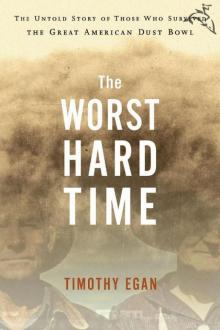 The Worst Hard Time: The Untold Story of Those Who Survived the Great American Dust Bowl
The Worst Hard Time: The Untold Story of Those Who Survived the Great American Dust Bowl The Good Rain: Across Time & Terrain in the Pacific Northwest
The Good Rain: Across Time & Terrain in the Pacific Northwest Breaking Blue
Breaking Blue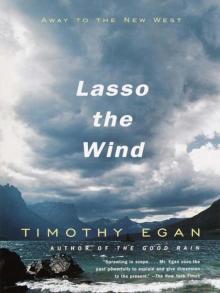 Lasso the Wind: Away to the New West
Lasso the Wind: Away to the New West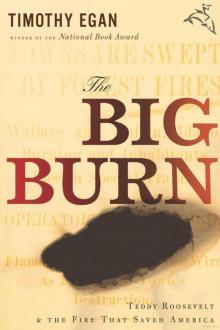 The Big Burn: Teddy Roosevelt and the Fire That Saved America
The Big Burn: Teddy Roosevelt and the Fire That Saved America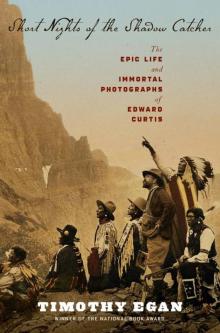 Short Nights of the Shadow Catcher
Short Nights of the Shadow Catcher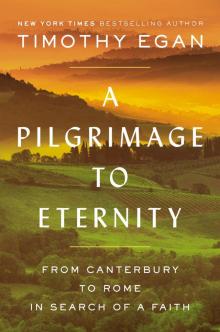 A Pilgrimage to Eternity
A Pilgrimage to Eternity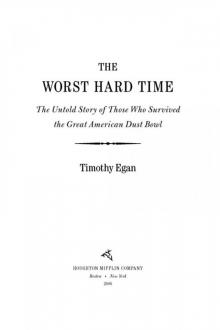 The Worst Hard Time
The Worst Hard Time The Big Burn
The Big Burn